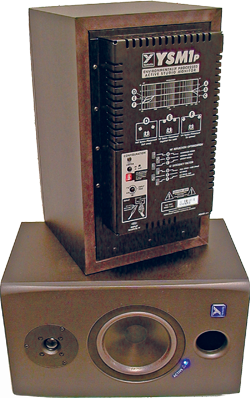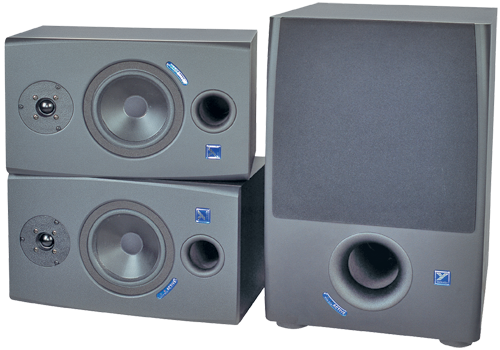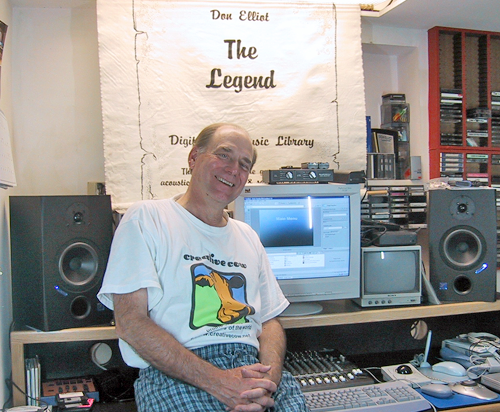By Don Elliot
Tears for Ears
Last week, my wife came down into the “Snake Pit” (my underground home studio, affectionately named after the old Hitsville, Detroit home studio because of the cabling everywhere), and looked at me funny.
“Why are you crying, honey, anything wrong?” she asked.
“I’m not crying,” I quickly and manfully replied, uh, through a crack in my voice!
“What is that wet stuff running from your eyes down your cheeks?” she insisted.
Indulge me… the following is a simple, but LONG answer.
I bade her sit down and listen to things with me that I had never heard before, or don’t remember hearing, what with the current wave of cheap “boom-box” quality speakers passing themselves off as studio-monitors which seem to have surfaced in many radio stations in the last few years. They are especially ubiquitous at the more cheaply run chains. No names mentioned. But their sound, which I had to live with for a while, made it seem like you were “flying blind.” Impossible to EQ with, even though they looked impressive, they were definitely, “all hat, no cattle.”
 Enter, Yorkville YSM1-P’s
Enter, Yorkville YSM1-P’s
I was trying out a set of new bi-amped speakers (YSM1-P) and subwoofer (YSS1) from Yorkville, based in Toronto, Canada. They are a manufacturer with very high quality standards. After hearing them recently in a convention hall, I asked the rep if I might borrow a set for a week to try them out in my studio space, which would be more of a fair test than the sound I was getting at the convention, which, nonetheless, was still way cool enough to have stopped me in my tracks. I reasoned, wow, if it sounds that nice here, I’ve GOT to hear these in my own studio surroundings!
When my wife crashed my “party,” I had just put on an ELO CD, recalling that there was a lot of nice instrumentation going on with Jeff Lynn in those days. Well, this was a defining moment of bittersweet all in a few seconds! Through the Yorkvilles, I heard sounds on that original recording I’d never before heard on that CD or even when the cuts were originally released years ago, probably when my hearing was even better! The definition, smoothness and imaging were breathtaking. The shimmering cymbals, the sonorous spread of gongs, the ringout of reverb, the articulation and breath in the vocals, the texture of the voices, the rhythmic slip and slide of brushes on snares, the tickling, vibrant rattle of tambourines… this was an emotional experience right up there with you-know-what!
I grabbed the midrange control on the console and tweaked it only 2 db. WOW! It just POPPED out of the monitor. Try THAT on a KRK or a Mackie monitor. I turned on the low end shelving on the board and heard the spot of the roll-off with dead-on accuracy. Next I put in an old audiotape cassette, just to be sure I could hear a lot of hiss! These monitors are the tool-of-the year for me!
I wrapped up the listening session with Al Schmitt’s Diana Krall re-release on the new Sony “Super-CD” format. This was the real test. And it was like being there. For a while, I thought I was even getting “the scent”! (Apologies to Al Pacino — Whooooah!)
Super Sensory Sensations
Ah, the other physical blessings we gain when we lose one of our senses! Most of us in this boat experience a heightened sharpness of one or more of our remaining senses: sight, hearing, taste, touch, smell. If you have all of your senses intact, you may relate to this by noticing the hyper-creativity and talent of people like Ray Charles, Stevie Wonder, Johnny Ray, Blind Bryan Lee from New Orleans, to name a few. The testimonial examples go on and on. Walt Disney had a medical condition that caused him to envision things when he heard sound. From this was born the movie Fantasia, so he could express it without losing his mind. In my own case, the loss of one eye since birth greatly enhances my sense of hearing and smell. Of course, this acute hyper-ness has always had a downside, such as being in burning buildings at an early stage before smoke detectors pick it up, being the ONLY one who knows WAY before anyone else, and then having insurance companies chase you down to be an expert witness. That part is not fun. Or being in a room and being able to tell you who had been there an hour before because their scent is still present. Maybe I should have become a wine taster and been paid to enjoy wine instead of the other way around… having to buy the wine! But then, this speaker article by a cheap wine snob would never have happened!
Ever since I was in my twenties, I knew I would stay in broadcasting and some form of music and recording. Most people buy insurance policies. I thought it would be wise to chart and graph my hearing every six months or so with a reputable ear clinic, so I would know if there was any loss over the years, and if so, in what frequency range, so I might compensate with EQ (or so I thought at the time! Read on! *). Little did I realize at the time that I had picked the best, the famed John House Ear Clinic in downtown Los Angeles, who over the years catered to the special needs of Ronald Regan, Rush Limbaugh and the like. In my last year at my last radio job, I suffered a severe ear injury and have avoided sound as much as I could ever since, and when I need to be exposed, I do so at low to moderate levels, lest I make a constant ringing condition any worse than it has been.
With the Yorkvilles, the response is so smooth and harmonious, I was able to monitor more loudly than before without aggravating my injury. The overtones and harmonics are clean and very present. A great test of this is violin or piano solos. There is no stridency to the midrange, yet they are not dark in the midrange. Quite an accomplishment! There is a built in peak limiter in the monitors, which you may turn on and off. They not only smooth out distorted peaks that could take out a tweeter at high levels, but are also a boon to protecting one’s hearing!

The Creature’s Features
Here are some great, unique features to these monitors that make them additionally “fanciable.”
1) No wires all over the studio between speakers and amps because they are Bi-amped. The only wires are the one pair from the console out to the monitors. 2) Footswitch for the sub-woofer on-off toggle. 3) Inputs: XLR, ¼” TRS “Combi-jacks”, RCA. 4) Variable crossover to accommodate different room sizes. At the high end, the choices are normal room, bright room, and dampened room. For the low end, the “LF efficiency factor” choice is for full space, half space or ¼ space (such as corner placement), and using this compensation keeps the low end flat despite its corner location! 5) Computer friendly; they won’t suck down the sides of the picture in a tube monitor, or spread the color into a gaussian smear up and down the sides of the screens, causing need to frequently de-gauss. 6) Built-in clip limiters (mentioned above), so you won’t fry the circuitry or your ears with feedback or other high-energy stuff. Boy, wouldn’t these have been cool when we used to rewind tape over the heads and take out tweeters at a few hundred bucks a pop… plus labor? Thermal protection with auto-reset is also a feature. 7) Small footprint.
I procured a piece of rubber mat material and cut it to size (from your local grocery store’s house wares section), and placed it under each nearfield to prevent scratching and vibration on the studio table. This also assured a lower likelihood of resonance to the tabletop, and kept them from sliding around, as well!

Yorkville’s Radio Studio Uses
So why are these so cool for RADIO production? You can edit all day long on them, and at even moderate to high levels in the near-fields, still simultaneously carry on a conversation over them without having to scream at the person sitting next to you.
Plus, there is a feature that totally one-ups the old “client pleaser knob.” Of course, those knobs were do-nothing switches, so that you could play “Emperor’s New Clothes” with the client by tweaking it, to which the client would invariably reply, “Oh yes, that’s much nicer…” And you hadn’t really done a THING to it! Well, THIS little knob is really a footswitch, and it REALLY DOES do something. It remotely turns the sub-woofer on and off. VERY handy when you want to let the v/o or jock-person get all impressed with their own pipes for playback. It’s also a REAL client pleaser switch or mix-checker when you kick it in so you can hear a full mix of something just for the pure enjoyment of it all!
The World Standard Speaker Guru “Drops Trou”
For many years, I have known the head of a world-class speaker manufacturing company that specialized in high-end speakers for the finest recording and production studios for music and film. They are the most expensive speakers I can think of. Not long ago, I learned that for some time that he had been having severe hearing problems. I was nearly aghast when I learned he was QC-ing every single speaker that went out of the factory BY EAR… HIS! I took him aside in private so as not to embarrass him, and asked how this was physically possible. I offered a scenario, where he might have a profound loss in the midrange at, say, ten db @ 4000 Hz. Would he not then compensate for that and make an effort to achieve a flat response for his own hearing sake by inadvertently jacking up the mids by +10 db? Never mind that my question inherently flawed when it begged the question, “Can you remember that long ago without the benefit of an immediate A-B then and now comparison”?
He said, “Don’t forget, MY reference is the real world.” (Insert The Big AHA, here!) In other words, he makes them sound like what he currently hears, and the result is flat! (That’s why, in the reference above*, before I learned this, I talked about initially thinking that one would have to compensate with EQ in this situation! I was wrong!). The explanation is so simple that its possibility completely eluded me, although I was on to something when I thought of the impossibility of a valid A-B because of the elapsed time in years since hearing with so-called perfect hearing.
Neighborly Advice or Whaddya Hear?
So, how do these speakers sound? Not long ago, my neighbor came over and wanted my advice on speakers. I asked him if he realized what he was asking and why not consider what sounded good to HIM? He fessed up that he really wanted a brand name that was cool so his buddies would also be impressed. Well, you could do a whole book on that subject, but after the buddies leave, YOU are the only one who has to be happy with them. If you can hear the difference, you want something that feeds that ability, for it is married to the talent in you and becomes a creative need.
We have all worked with transmitter engineers who were assigned to studio work as well, and couldn’t fix an audio problem because they couldn’t hear it! And if you can’t hear it, you can’t fix it! There is also the philosophy of “good enough for who it’s for!”
Where am I going on this roundabout rant? It’s about MY opinion, Don Elliot’s opinion. It’s subjective. BUT… because of what I have learned over the years, coupled with my EXPERIENCE, my subjectivity is kind of OBJECTIVE! It’s like hearing an overview of a standard. Read that last line twice, because it says a lot. It’s like having a standard and having the ability to judge things against that standard with your ears. When you acquire it, you’ll be better equipped to make things sound better than something else (remember “A-B” comparisons?) in order to be competitive on the radio!
I like to make my imaging or promos sound bigger than a barn door on the air and where they print SOooo well that they actually sound better than the music of the station’s format!
Remember the howl and complaints that “the commercials are too loud” in the middle of the TV movie? “It’s a conspiracy with advertisers,” etc. Have you ever figured out that the spot was recorded THIS WEEK and the movie was made 5 to 30 years ago? The commercial is at the state of the art for processing. The movie is probably being played in its old, original form, with a mic hung in the ceiling using film-audio techniques.
I give all these comparisons to illustrate the point that you have to be able to accurately hear what you are doing in production, because sound is really your only products. Or, as with the earlier engineering lament, “If you can’t hear it, you can’t fix it.” And sadly, we are now programming to listeners who are listening on equipment that is better than what we are using to produce the content!
So, Do You Think Speakers Are Important For Radio Yet?
So where do you get off, Elliot? Where, then, does my supposed “superlative subjectivity-that-is-really-objective-too” come from? I grew up with a scholarship to a major Conservatory of Music as a French Horn player studying to become a conductor. When the draft came along, I tried to join the Air Force as a jet-pilot after ROTC, but “they weren’t taking any one-eyed pilots today, sonny, thank you! By the way, horn playing, orchestra conducting, jet-pilot and radio production are REALLY all the SAME job when you think about it. It’s about control, being on top of your game and being better than the next competitor, and above all, CREATIVITY! And think about it: we do all fly by the seats of our pants for the pure thrill of it, too!
I cut my chops with a couple of folks who, apparently (as history later proved), knew what they were doing. Dave Hassinger and Al Schmitt from RCA, in the days of recording The Rolling Stones in Hollywood, allowed me in on sessions as I was training to become a “second” engineer. Later, guys like Charlie Underwood, Greene and Stone (Sonny and Cher), David Knight (The Pointer Sisters), Bruce Botnik at Sunset Sound (The Turtles), Neil Young and Crazy Horse at SunWest, Bob Lentini (wrote the SAW program), and Steve Williams/Bernie Becker (Neil Diamond engineer-producers), all influenced my attitude on how to effectively and competitively mix sound. No, I didn’t get that second-engineer gig after all; I was too busy being a “Super-Star” (don’t we all think that way for a moment?) morning jock. But that great experience did teach me one thing: how to build, produce and mix a promo like a hit record, so that every time you listened to it, you’d hear something else new, and the cut will have a lot of listenability and wearability! No, I NEVER made million-dollar sounding promos at microwave speed or caved to the request to build 14 more just like it by the end of the day! Argh, auck, (finger down throat gesture here).
Why did I go through all this in a review for speakers? Credibility! I wanted you to know that I knew what I was talking about first, and that I had walked the walk, when I say these speakers are way cool!
 Get Real
Get Real
Don’t forget, your reference in mixing is real-life. And in real life, it ain’t for a level. You only get one take. Do it right. These speakers will help you get there and be very happy along the way. And yes, there may even be a “happy tear” or two!
List Prices as of this writing: Nearfield YSM1P $320 each. Subwoofer YSS1 $459. (Common street prices are around 10-15% off this price.) Available through Ruben Lugo, District Manager, Yorkville Sound, (714) 883-6351.
♦

